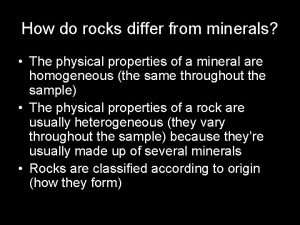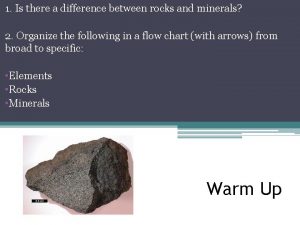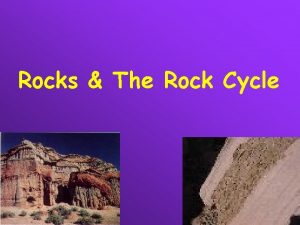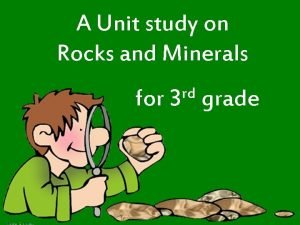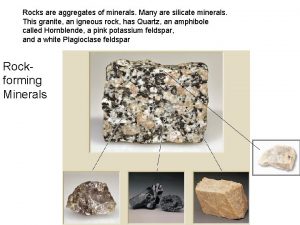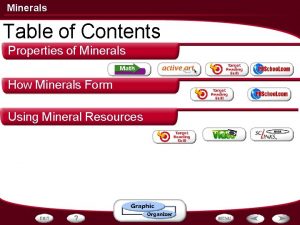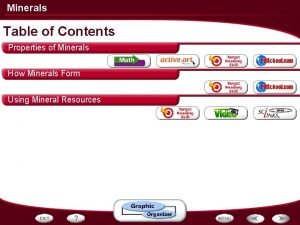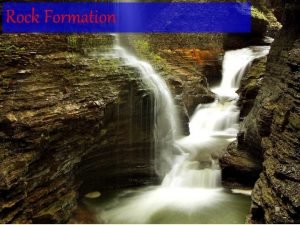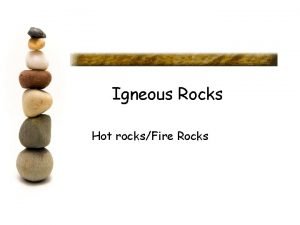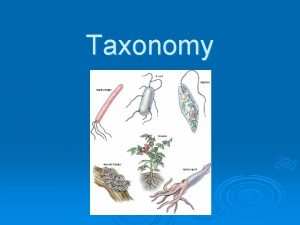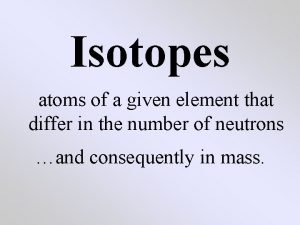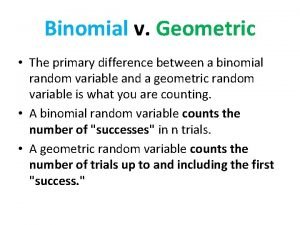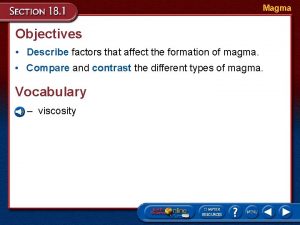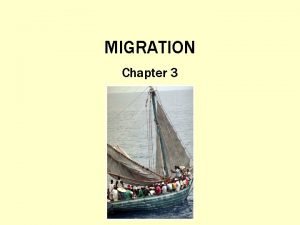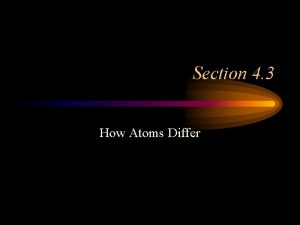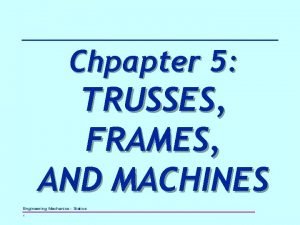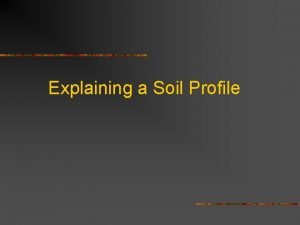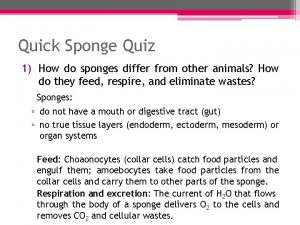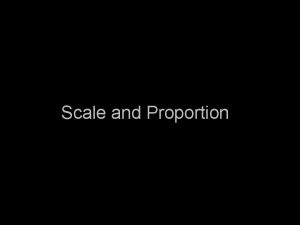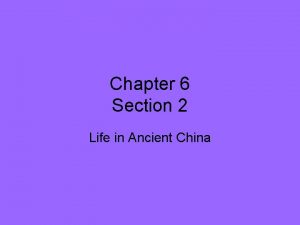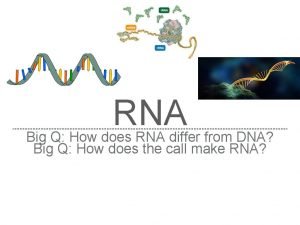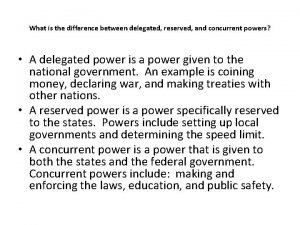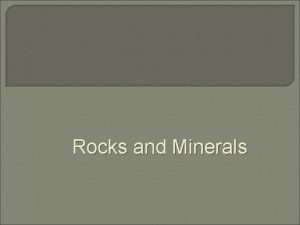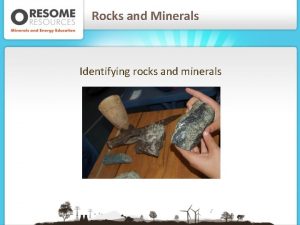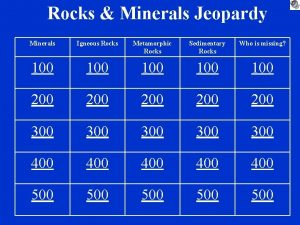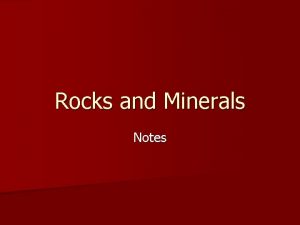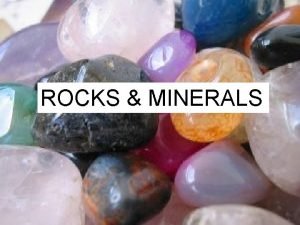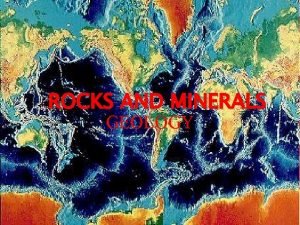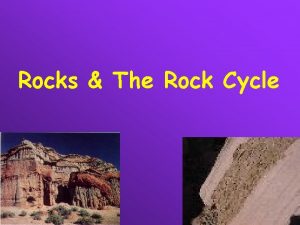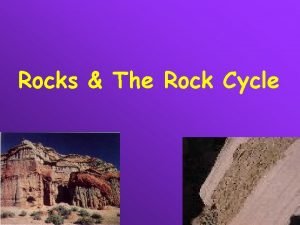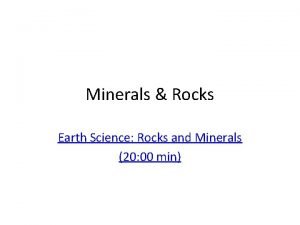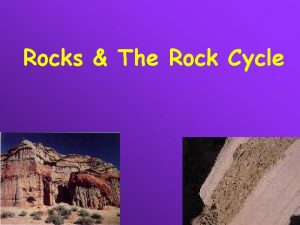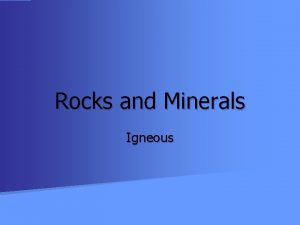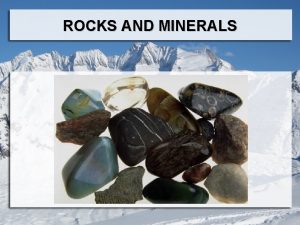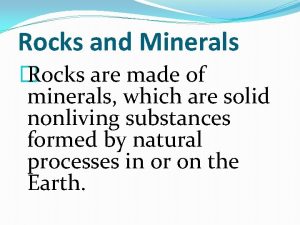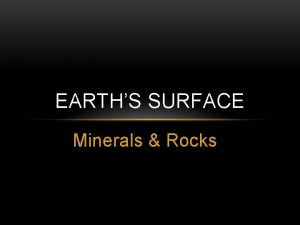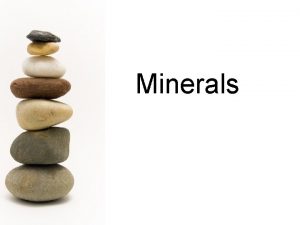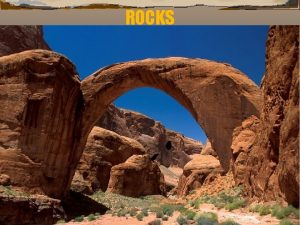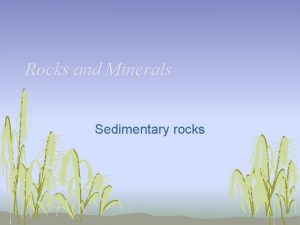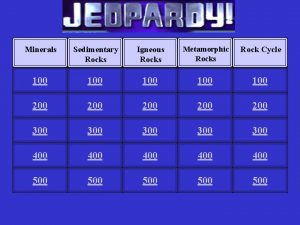How do rocks differ from minerals The physical







































































































- Slides: 103

How do rocks differ from minerals? • The physical properties of a mineral are homogeneous (the same throughout the sample) • The physical properties of a rock are usually heterogeneous (they vary throughout the sample) because they’re usually made up of several minerals • Rocks are classified according to origin (how they form)

These minerals are all in this rock

Rock Classification – 3 major groups based on their methods of formation or origin 1. Igneous rocks … from cooling and solidification of lava or magma 2. Sedimentary rocks … from compacted and cemented sediments, or chemical precipitates or evaporites 3. Metamorphic rocks … meta (change) morphic (form) … rocks changed by heat and pressure – but remain solid

SEDIMENTARY ROCKS


Sedimentary Rocks • 80 % of Earth’s surface is covered with sediments and Sedimentary Rocks

What is sediment? ? q Broken pieces of rocks called CLASTS q Chemical precipitates ( dissolved solids come out of solution) q Organic fragments – shells, decayed plant matter – this is called BIOCLASTIC

Sedimentary Rocks form when sediments/clasts are transported to large bodies of water and are … Deposited in horizontal layers called beds or strata Buried Compacted – particles forced extremely close together because of the pressure of the overlying layers and water Cemented – glued together

Sedimentary Rocks q Sediments that are eroded settle to the bottom of the rivers, lakes, and oceans q Layer after layer of eroded earth is deposited on top of each other

Cementing Material (Glue) • Minerals precipitate out of solution to cement particles together. Cementing material is often quartz, calcite, and hematite Most Sedimentary Rocks form under large bodies of water, such as lakes, seas, and oceans

Horizontal layers deposited under water

Classification of Sedimentary Rocks • We classify sedimentary rocks depending on whether the sediments came from – Particles of other rocks (“land derived”) – Ions that have precipitated out of seawater (“chemically derived”) – Living organisms (“organically derived”)


Sand Composition Varies BUT TO BE CONSIDERED SAND THE GRAIN SIZE IS BETWEEN 0. 2 -0. 006 CM.

Sedona Sandstone

Sediments are pebbles, cobbles, and boulders rounded Breccia angular

Silt (0. 006 to 0. 0004 cms. SILTSTONE Sand (0. 2 to 0. 006 cms. ) SANDSTONE Clay (less than 0. 0004 cms. ) SHALE

Shale Source: Photograph © The Mc. Graw-Hill Companies, Inc. /Bob Coyle, photographer.

Sandstone Source: Photograph © The Mc. Graw-Hill Companies, Inc. /Doug Sherman, photographer.


2 TYPES OF TEXTURE q CRYSTALLINE FOR CHEMICALLY FORMED SEDIMENTARY ROCKS q BIOCLASTIC FOR ORGANICALLY FORMED SEDIMENTARY ROCKS q HOW USEFUL IS GRAIN SIZE? ?

CHEMICAL Sedimentary Rocks Sediment From Solution q All liquid water contains dissolved minerals. q These minerals precipitate (dissolved solids come out of solution/water) q Usually happens because of evaporation q They are monominerallic – consisting of intergrown crystals of just 1 mineral. q Form in shallow seas

ROCK SALT Intergrown crystals of just 1 mineral DOLOSTONE ROCK GYPSUM


ORGANIC Sedimentary Rocks Bioclastic Sediment LIMESTONE AND CORALS • Dissolved minerals taken out of solution by marine organisms for their hard parts (shells) can pile up on the seafloor when they die. • These fossil remains accumulate into a thick enough layer to form an “organic” sedimentary rock • Cement is commonly calcite ( bubbles with acid) COAL • Decayed plant remains

BIOCLASTIC LIMESTONE COAL CHEMICALLY PRECIPITATED LIMESTONE

Centralia Pennsylvania Coal Fire • http: //dlbtboces. org/webapps/portal/frameset. jsp? t ab=courses&url=%2 fbin%2 fcommon%2 fco urse. pl%3 fcourse_id%3 d_2495_1


Summary q Inorganic Land-Derived Sedimentary Rocks are identified by Texture or Grain Size q. Chemically and/or Organically Formed Sedimentary Rocks are identified by Composition What conditions control which Sedimentary Rock is formed? ? ?

THE SIZE OF THE GRAIN IS DETERMINED BY THE ENVIRONMENT OF FORMATION q HIGH ENERGY ENVIRONMENT Large particles Fast moving water – rivers, ocean waves q LOW ENERGY ENVIRONMENT Small particles Slow moving water – lake, bay, swamp


SEDIMENTARY ROCK WHERE IT WAS PUT TOGETHER CONGLOMERATE BRECCIA HIGH ENERGY SANDSTONE MEDIUM ENERGY SILSTONE LOW ENERGY SHALE VERY LOW ENERGY

Environment of Formation Ocean Derived Sedimentary Rocks help us understand our past geologic history There is evidence of climate change as well as lost species of plants and animals in Sedimentary Rocks

During the Cretaceous Period (about 120 mya) a shallow inland sea split North America. We know this by the Sedimentary Rocks deposited in the former shallow sea

Cretaceous Limestone Deposits in Kansas


SALT AND GYPSUM EVAPORATION q Bedrock of Salt and Gypsum around Buffalo q What type of environment would cause salt and/or gypsum to evaporate? q Ocean environment with hot temperatures

CHARACTERISTICS OF SEDIMENTARY ROCKS 1. Horizontal layers called beds or strata 2. Clasts are rounded and sorted because they have been moved by water 3. Ripple Marks 4. Mud Cracks 5. Fossils 6. Interconnected mineral crystals of 1 mineral (monominerallic)

HORIZONTAL LAYERS

A. SHALLOW WATER B. LOW ENERGY C. DIRECTION OF FLOW

MUDCRACKS ALTERNATING WET AND DRY CONDITIONS

Limestone - FOSSILS

IGNEOUS ROCKS

MAGMA VS. LAVA Magma – molten material BELOW the surface of the Earth Lava – molten material AT OR ABOVE earth’s surface

ENVIRONMENT OF FORMATION COOLING HISTORY MAGMA LAVA Intrusive – below the surface Extrusive - above the surface A pluton is a body or chamber Ejected from volcano of magma deep inside the crust. Rocks formed when magma Rocks formed when lava cools and solidifies are called INTRUSIVE (PLUTONIC) EXTRUSIVE (VOLCANIC)

EXTRUSIVE FEATURES VOLCANO - landforms generated when lava is released from the Earth’s interior through openings.


Magma Intrusive Features - Plutonic

Formation of Igneous Rocks q. COOLING AND SOLIDIFICATION OF MAGMA/LAVA q. INTERGROWN OR INTERCONNECTED SILICATE CRYSTALS IN A RANDOM PATTERN – NOT ORGANIZED


IGNEOUS ROCKS ARE CLASSIFIED BASED ON 2 MAIN CHARACTERISTICS • TEXTURE – MINERAL GRAIN SIZE • MINERAL COMPOSITION

What controls texture? How fast an igneous rock cools. What controls how fast an igneous rock cools? Where the rock is formed. slower cooling coarser crystals deep in ground

ESRT – TOP OF THE IGNEOUS ROCK SCHEME TELLS THE TEXTURE / GRAIN SIZE

Classification of Igneous Rocks – Texture or Grain Size Extrusive Intrusive Volcanic - LAVA Volcanic- LAVA Plutonic - MAGMA Extremely fast Fast Cooling cooling Slow Cooling Extremely slow cooling Non. Fine-grained crystalline Glassy vesicular (gas pockets) Coarsegrained Very Coarsegrained

EXTRUSIVE – VOLCANIC - LAVA • When lava cools extremely fast crystals have no time to form – JUST FROZEN IN PLACE RANDOMLY WHEN LAVA ENTERS ATMOSPHERE OR WATER • GLASSY – NON-CRYSTALLINE Non-vesicular Vesicular gas pockets

EXTRUSIVE – VOLCANIC - LAVA Lava that cools fast at or near the Earth’s surface Produces small crystals FINE-GRAINED TEXTURE not easily seen with the naked eye.

INTRUSIVE – PLUTONIC - MAGMA Magma that cools slowly deep underground produces large crystals COARSE-GRAINED TEXTURE easily seen with the naked eye.

INTRUSIVE – PLUTONIC - MAGMA EXTREMELY SLOW COOLING HAS ABNORMALLY LARGE CRYSTALS AND IS VERY COARSE.

What does granite bedrock exposed at the surface indicate?

COOLING HISTORY / GRAIN SIZE ALONE CANNOT NAME THE ROCK WE NEED TO KNOW COMPOSITION TEXTURE + COMPOSITION = ROCK CAN BE IDENTIFIED

THE BOTTOM OF THE IGNEOUS ROCK SCHEME TELLS YOU THE COMPOSITION TEXTURE + COMPOSITION CAN NAME ROCK

Igneous Rocks Consist of 7 Silicate Minerals Quartz Potassium feldspar Plagioclase feldspar Biotite mica Amphibole (hornblende) Pyroxene Olivine NO SINGLE IGNEOUS ROCKS IS MADE UP OF ALL 7 MINERALS

FELSIC VS. MAFIC FELSIC MAFIC “FEL” = FELDSPARS “MA” = MAGNESIUM “SIC” = SILICA “F” = IRON High % of quartz, feldspars, mica “IC” = SILICA High % of pyroxene, feldspars, amphibole DARKER IN COLOR LIGHTER IN COLOR LESS DENSE

FELSIC COMPOSITION COLUMN + COARSE TEXTURE ROW

IGNEOUS ROCK COMPOSITION FELSIC ROCKS – CONTINENTAL CRUST GRANITE – coarse-grained (continental crust) RHYOLITE – fine-grained OBSIDIAN - glassy and PUMICE - porous (vesicular). PEGMATITE - very coarse-grained

IGNEOUS ROCK COMPOSITION MAFIC ROCKS –OCEANIC CRUST GABBRO – coarse-grained BASALT – fine-grained (ocean crust) SCORIA – vesicular (gas pockets) VESICULAR BASALT – vesicular

IGNEOUS ROCK COMPOSITION INTERMEDIATE ROCKS MIXED FELSIC/MAFIC MIXED CRUST ANDESITE (named for Andes Mountains) – fine-grained 2 nd most abundant volcanic rock in Earth’s crust. DIORITE – coarse-grained

IGNEOUS ROCK COMPOSITION ULTRAMAFIC ROCKS – form from magma in ASTHENOSPHERE Dominated by Fe-Mg silicates, olivine and pyroxene. Very dark in color and dense Found at converging continental plate boundaries. Peridotite Dunite

INTRUSIVE EXTRUSIVE Granite Rhyolite Figure 4. 7 A MINERAL COMPOSITION THE SAME – TEXTURE ONLY DIFFERENCE Intrusive vs. Extrusive

INTRUSIVE EXTRUSIVE MINERAL COMPOSITION THE SAME ---- TEXTURE ONLY DIFFERENCE Andesite Diorite Intrusive vs. Extrusive

INTRUSIVE Gabbro EXTRUSIVE Basalt MINERAL COMPOSITION THE SAME – TEXTURE ONLY DIFFERENCE Intrusive vs. Extrusive

Lava Field at Sunset Crater

WHAT GRAPH BELOW SHOWS AS TIME INCREASES THE SIZE INCREASES? A B

METAMORPHIC ROCKS

METAMORPHIC ROCKS META = CHANGE MORPH = FORM q Called the “Cinderella Rock” q Start with pre-existing rock and change to another rock – but these changes occur in the SOLID STATE

METAMORPHISM q Process by which igneous, sedimentary, or another metamorphic rock called the “parent rock” undergoes changes in minerals and texture

METAMORPHISM Occurs in rocks due to the effects of • High temperature (but not high enough to melt!) • High pressure

HEAT EFFECTS q Temperature increases with depth or contact with magma q Recrystallization – a process that forms new mineral crystals because the mineral is no longer stable at the new temperature • Changes to a new (high temperature) mineral

PRESSURE EFFECTS q Pressure increases with depth – weight of overlying rock (see page 10 ESRT) q Mineral crystals grow larger q Mineral crystals are more dense q Mineral crystals grow perpendicular to pressure q Mineral crystals are arranged in parallel layers – PRODUCES FOLIATION

FOLIATION q Pressure actually rearranges the minerals into parallel layers. q More pressure – minerals grow larger and recrystallize and separate into layers q Even more pressure – alternating layers of light and dark minerals called Banding


Random arrangement of minerals Organized arrangement of minerals - banding

Granite Intergrown crystals random pattern Gneiss Intergrown crystals Organized Pattern

2 Types of Metamorphism 1. Regional Metamorphism – Occurs over large areas where there is active mountain building a) Convergent plate boundaries 2. Contact Metamorphism – areas in contact with magma intrusions and/or lava extrusions

MOUNTAIN BUILDING

Classification of Regional Metamorphic Rocks q Composition is basically the same for all foliated rocks – parent rock is usually listed in comments section. q Type of texture and grain size determined by the amount of heat and pressure


GRADES OF METAMORPHISM LOW GRADE – LESS HEAT AND PRESSURE – SLATE HIGH GRADE – MORE HEAT AND PRESSURE - GNEISS

Temperature q. Low-grade metamorphism: Occurs at about 2000 C to 5000 C. and pressure greater than 1, 000 atmospheres q. High-grade metamorphism: Occurs at > 5000 C

FOLIATED METAMORPHIC ROCKS

MICA SCHIST WITH GARNET MICA CRYSTALS BECOME LARGE AND SPANGLY

Grand Teton Gneiss

METAMORPHIC ROCKS WILL OFTEN BE DEFORMED BECAUSE OF INTENSE HEAT AND PRESSURE LOOK AT ROCK SYMBOL FOR GNEISS

A metamorphic rock exposed to too much heat will melt and become ? ? ? MAGMA

q Near magma chambers (plutons) q Rocks in “contact” with the magma are baked q New minerals are formed – recrystallization q Transition zone of contact metamorphism is usually relatively narrow baking the adjacent rocks

Contact Metamorphism – Baking the adjacent rocks

Symbol for Contact Metamorphism is a line with tick marks When limestone undergoes contact metamorphism what rock will it metamorphose into? Sandstone? ?

PARENT ROCK IN THE COMMENTS

LIMESTONE METAMORPHOSES INTO MARBLE

SANDSTONE METAMORPHOSES INTO QUARTZITE

Rock Classification Summary • If the rock looks “dirty” or contains fossils, it’s sedimentary • If the rock shows banding or folds or twists or mineral alignment, it’s metamorphic • If the rock is glassy or contains rounded crystals or gas pockets, it’s igneous

Rock Distribution • Sedimentary rocks are at or near the Earth’s surface because they require water to form • Igneous rocks are found near volcanoes and deep underground. • Metamorphic rocks are found deep within mountains, deep underground, and at transition zones between sedimentary and igneous rocks

ANY TYPE OF ROCK CAN BE CHANGED INTO ANY OTHER TYPE OF ROCK
 Igneous vs metamorphic
Igneous vs metamorphic Igneous rock to metamorphic rock
Igneous rock to metamorphic rock Rock vs mineral
Rock vs mineral Whats the difference between rocks and minerals
Whats the difference between rocks and minerals Quartzite rock cycle
Quartzite rock cycle Difference between rocks and minerals
Difference between rocks and minerals Rocks and minerals
Rocks and minerals Rocks are aggregates of minerals
Rocks are aggregates of minerals Concept mapping rocks and its classification
Concept mapping rocks and its classification What type of rock is this
What type of rock is this Suzanna socked me sunday poem
Suzanna socked me sunday poem Solid rock
Solid rock Intrusive vs extrusive igneous rocks
Intrusive vs extrusive igneous rocks Naviance lasa
Naviance lasa Chemical change in baking
Chemical change in baking How does a physical change differ from a chemical change
How does a physical change differ from a chemical change Physical properties of minerals graphic organizer answer
Physical properties of minerals graphic organizer answer Physical properties of minerals graphic organizer
Physical properties of minerals graphic organizer How are rocks formed
How are rocks formed What are the physical properties of igneous rocks
What are the physical properties of igneous rocks Các châu lục và đại dương trên thế giới
Các châu lục và đại dương trên thế giới Mật thư tọa độ 5x5
Mật thư tọa độ 5x5 Bổ thể
Bổ thể Tư thế ngồi viết
Tư thế ngồi viết V. c c
V. c c Thẻ vin
Thẻ vin Thể thơ truyền thống
Thể thơ truyền thống Bài hát chúa yêu trần thế alleluia
Bài hát chúa yêu trần thế alleluia Từ ngữ thể hiện lòng nhân hậu
Từ ngữ thể hiện lòng nhân hậu Hổ sinh sản vào mùa nào
Hổ sinh sản vào mùa nào Diễn thế sinh thái là
Diễn thế sinh thái là Vẽ hình chiếu vuông góc của vật thể sau
Vẽ hình chiếu vuông góc của vật thể sau Làm thế nào để 102-1=99
Làm thế nào để 102-1=99 Tỉ lệ cơ thể trẻ em
Tỉ lệ cơ thể trẻ em Lời thề hippocrates
Lời thề hippocrates Vẽ hình chiếu đứng bằng cạnh của vật thể
Vẽ hình chiếu đứng bằng cạnh của vật thể đại từ thay thế
đại từ thay thế Quá trình desamine hóa có thể tạo ra
Quá trình desamine hóa có thể tạo ra Cong thức tính động năng
Cong thức tính động năng Môn thể thao bắt đầu bằng chữ đua
Môn thể thao bắt đầu bằng chữ đua Sự nuôi và dạy con của hươu
Sự nuôi và dạy con của hươu Thế nào là mạng điện lắp đặt kiểu nổi
Thế nào là mạng điện lắp đặt kiểu nổi Hát kết hợp bộ gõ cơ thể
Hát kết hợp bộ gõ cơ thể Các loại đột biến cấu trúc nhiễm sắc thể
Các loại đột biến cấu trúc nhiễm sắc thể Thế nào là sự mỏi cơ
Thế nào là sự mỏi cơ Phản ứng thế ankan
Phản ứng thế ankan Chó sói
Chó sói Thiếu nhi thế giới liên hoan
Thiếu nhi thế giới liên hoan điện thế nghỉ
điện thế nghỉ Một số thể thơ truyền thống
Một số thể thơ truyền thống Trời xanh đây là của chúng ta thể thơ
Trời xanh đây là của chúng ta thể thơ Thế nào là hệ số cao nhất
Thế nào là hệ số cao nhất Slidetodoc
Slidetodoc Hệ hô hấp
Hệ hô hấp Số.nguyên tố
Số.nguyên tố Vẽ hình chiếu vuông góc của vật thể sau
Vẽ hình chiếu vuông góc của vật thể sau đặc điểm cơ thể của người tối cổ
đặc điểm cơ thể của người tối cổ Các châu lục và đại dương trên thế giới
Các châu lục và đại dương trên thế giới Chụp tư thế worms-breton
Chụp tư thế worms-breton ưu thế lai là gì
ưu thế lai là gì Tư thế ngồi viết
Tư thế ngồi viết Bàn tay mà dây bẩn
Bàn tay mà dây bẩn How does bryan's view of science differ from that of malone
How does bryan's view of science differ from that of malone Dried meat market form
Dried meat market form A single str may differ between two unrelated people by
A single str may differ between two unrelated people by What five probable ancestors of the modern bird
What five probable ancestors of the modern bird Is a report formal or informal
Is a report formal or informal Given the atomic notation of 64/30 zn
Given the atomic notation of 64/30 zn Appreciation and criticism
Appreciation and criticism The difference between signs and symbols
The difference between signs and symbols How do littoral zones differ from riparian zones?
How do littoral zones differ from riparian zones? Binomial vs geometric distribution
Binomial vs geometric distribution Difference primary and secondary market
Difference primary and secondary market Dark romanticism elements
Dark romanticism elements How do the origins of folk and popular culture differ?
How do the origins of folk and popular culture differ? Types of magma
Types of magma Explain how adp and atp are each like a battery
Explain how adp and atp are each like a battery Stratxsimulations login
Stratxsimulations login Calm area where warm air rises
Calm area where warm air rises Define cyclic movement
Define cyclic movement Standards vs procedures
Standards vs procedures Greert vinck is 29 years old
Greert vinck is 29 years old Formal linguistics definition
Formal linguistics definition Section 3 how atoms differ
Section 3 how atoms differ Explain how securities firms differ from investment banks
Explain how securities firms differ from investment banks Buffalo and toronto differ in four major ways
Buffalo and toronto differ in four major ways How formal education differ from als
How formal education differ from als Difference between trusses and frames
Difference between trusses and frames Straight news story
Straight news story Easterlies
Easterlies Thumus
Thumus The plastic cape used in draping should be
The plastic cape used in draping should be Bat characteristics
Bat characteristics How do series and parallel circuits differ?
How do series and parallel circuits differ? Sponge gastrovascular cavity
Sponge gastrovascular cavity What is cyclic movement
What is cyclic movement How metric chasing dial differ from british chasing dial
How metric chasing dial differ from british chasing dial How do the origins of folk and popular culture differ
How do the origins of folk and popular culture differ Scale vs proportion art
Scale vs proportion art Why did aristocrats like the philosophy of legalism?
Why did aristocrats like the philosophy of legalism? How does rna differ from dna? *
How does rna differ from dna? * Difference between delegated concurrent and reserved powers
Difference between delegated concurrent and reserved powers A single str may differ between two unrelated people by
A single str may differ between two unrelated people by How does interpretation b differ from interpretation a
How does interpretation b differ from interpretation a


